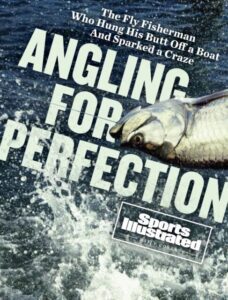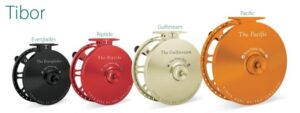This at times bizarre 1973 film is referenced in “Lords of the Fly” by Monte Burke, released in 2020.
“As the tarpon neared, he made one long, slow strip of the line. The fish veered toward the fly, engulfed it, and leapt, its body lurching completely out of the water, before crashing back in. It was, as Huff would later recall, as if someone had dropped a Steinway piano into the ocean from a helicopter.” Burke, Monte. Lords of the Fly: Madness, Obsession and the Hunt for the World-Record Tarpon. Pegasus Books, 2020.

You may have already heard about the recently released book, “Lords of the Fly: Madness, Obsession and the Hunt for the World-Record Tarpon” by Monte Burke.
It was featured on a September 2020 Orvis podcast, a Sports Illustrated Daily Cover throwback (below), and in the book review section of The Wall Street Journal.
While plenty of fly fishing books are released every year, few if any receive mainstream coverage from the likes of SI and WSJ. If you haven’t picked up your virtual copy from the library or a glossy new hardcover edition, this review may spur you into action.

Monte Burke has written two other books on fishing, one of which is also a book about chasing records (largemouth bass). “Lords of the Fly” is ultimately about establishing new records and beating existing records in the world of tarpon fishing.
The primary setting is Homosassa, north of Tampa, as well as the Florida Keys. The key characters are client Tom Evans and guide Steve Huff; however, numerous (mostly) men come and go over the course of the story, including many saltwater fly fishing legends.
This non-fiction book centers on Evans’s decades-long dedication to trophy tarpon fishing. The larger theme is Melvillian monomania with regards to International Game Fish Association Fly Tackle World Records for Tarpon.
I’ve screen-shot the current male and female records below, and you can access details and history at IGFA.org. Little did I know that there are separate records for 2 lb., 4 lb., and 6 lb. tippet strengths.
If you want to hear a thoughtful interview with Nathaniel Linville of The Angling Company and learn how the heck he landed a 140-lb. fish on 6 lb. test last year, check out Mill House podcast. Read his blog post of the record catch here.

Back to the book – I’d rather not ruin the story for you, as each reader will take something different from the 274 pages of this book. I will say that it is superlative in its research, interviews, and writing. By reading it, you will become versed in the nuances of IGFA standards and certifications as well as the changing ecology of Florida, not to mention the history of sport-fishing for “the silver king.”
I learned about the special leader formulas for IGFA records, Homosassa watercolors by Winslow Homer, and the collateral damage that can result from becoming hellbent on beating sport-fishing records.

A few themes that I’ll touch on – the transition from 12 lb. to 16 lb. tippet, Ted Williams, and Tibor reels:
- When some folks began using 16 lb. instead of 12 lb. leaders for giant tarpon in the late 20th century, certain anglers and guides dismissed them as “not really tarpon fishing” (I’m generalizing from the book here). This reminds me of when trout anglers label using brightly colored nymphs, worm imitations, or mop flies as “not really trout fishing.” In my opinion, both of these viewpoints are equally silly.
- There are several stories centering on Ted Williams which are worth of the price of admission alone. Burke expertly captures interactions with the Baseball Hall of Fame and IGFA Hall of Fame inductee, arguably one of the greatest fly anglers in history.
- Burke discusses the draw of Tibor reels for tarpon fishing, particularly saltwater offerings such as The Riptide and The Gulfstream with their signature clicking sounds. Tibor reels are to giant tarpon fishing what Hardy reels are to Atlantic salmon fishing.

After putting down this book, I flip-flopped between an accelerated desire to challenge myself in the high stakes game of targeting giant tarpon and an aversion to the hyper competitive crowded scene of Florida Keys flats fishing.
I also struggled with the simultaneous urges of conservation and recreation as Megalops atlanticus is officially labeled as a “vulnerable” species with a decreasing population by the International Union for Conservation of Nature and Natural Resources.
Regardless, I’ve certainly become more conscious of what it means to contribute to the increased pressuring of Atlantic tarpon, but am optimistic that informed decisions by anglers and support from organizations like Bonefish & Tarpon Trust will help.
In fact, there’s only one legal way in Florida to kill a tarpon or take a tarpon over 40 inches out of the water – by purchasing a “Tarpon Tag” for $51.50. This enables you to bring the fish into your vessel so that it is thus “retained for potential IGFA record” (sourced from the Florida Saltwater Recreational Fishing Regulations). Clearly, Florida recognizes that the tarpon must be conserved, but that there are still those among us on the quest to get their names atop the leader board.
It’s going to be a while before another fly fishing book enters the mainstream like “Lords of the Fly” has. I encourage you to experience it and let me know what your thoughts are.
Discover more from BlogFlyFish.com
Subscribe to get the latest posts sent to your email.

Wow incredible. Look like many of the women’s records are definitely attainable. Let’s go ladies. Good luck. Thx for the recommendation.
Enjoy the book Bob, I couldn’t put it down once I picked it up, a great read.
Thanks for the recommendation. I look forward to reading the book.
You’re welcome Bill, I think you’ll enjoy it, though it makes me pine for warmer climates during this February winter.
Whoah nice find on the Jack Dennis tarpon video David. My first fly tying book was fly tying with Jack Dennis and friends- so I was excited when I met him at his fly shop in Jackson Hole several years ago. We had a lively conversation- the funny thing was we talked about baseball and didn’t talk fishing at all!
Jamie – very cool! Yes check out his YouTube channel, it has a bunch of rarities.